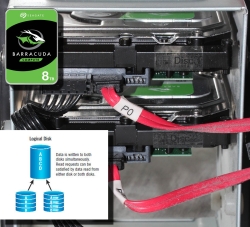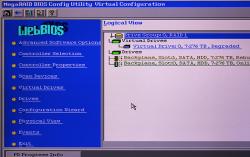On my home Linux server I ran out of disc space on my 2 TB hard drive. Or, technically speaking there were hundred or so unallocated megs left on my Logical Volume Manager. That translates as I hadn't yet ran out, I was about to run out of space. There was some reserves left, but it would have required some LVM-tinkering to do to unleash what was left into actual use.
---> To hardware shopping!
This is what I got:

That's a pair of 8 TB Seagate Barracudas hooked up into my old-but-trustworthy LSI MegaRAID.

Yeah, you read it right. BIOS is from year 2011. The logical volume / virtual drive created by 90s-looking WebBIOS looks really nice with all those terabytes:

Hint: Don't do what I did and forgot to hook up one S-ATA power cable properly after finalizing installations. The mirrored RAID-1 -drive will need rebuil. On this particular LSI MegaRAID such rebuild takes ~20 hours to complete. Good thing, the drive was fully available during the operation. It did respond bit slowly during rebuild, but that's what spinning platters do anyways.
Amounts of data I seem to have lying around at my home server is a handful. This simple LVM-tinkering sequence of vgextend / pvmove took nearly five hours to complete. This is one of the multiple advantages of having a logical volume, there exists capability to tell at which physical drive a volume resides at.
When I made the purchase order for new drives, I was considering whether I should not use LVM anymore and go for btrfs. Obvious advantage if upgrade would give me even more flexibility on disc space allocation. On negatives, such transition would require for me to copy all data from old LVM/Ext4 drives to new btrfs-drive. LVM's transition simplicity of entire file system without touching individual files did it for me and I chose to not go for The New Thing™.
Hopefully these platters keep spinning for many years to come.